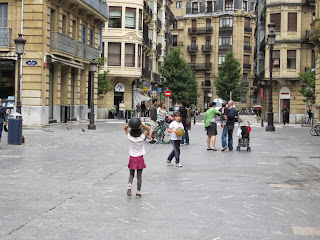 |
| Neighborhood grassroots campaign in Austin to get the City to install a stop sign |
In talking to Austin parents, many express frustration with how unsafe it is for their kids to walk to school, play in the streets, or access nearby amenities on foot. By no means is Austin unique in this regard. As a writer in the Atlantic Monthly lamented earlier this year:
This is the point we have come to in much of the developed world: The freedom for a child to walk out the door and skip rope or play catch is something that has to be scheduled, organized, and officially permitted.
And for parents trying to get basic safety improvements installed, the process can be maddening, quickly leading to roadblocks and dead-ends.
Luckily, there are three great new developments that will help make our streets safer in Austin:
First, the Austin City Council has formed a new Pedestrian Advisory Council to help guide the City as it looks to improve walkability in the city. The Council, which is modeled on the City's Bicycle Advisory Council, meets for the first time this week on October 22nd, 5:30, at City Hall.
Second, Austin has a new grassroots coalition, WalkAustin, committed to transforming Austin into a pedestrian-friendly city. Earlier this year, the coalition put on a walkability summit to launch a citywide conversation about promoting walking in the city. As I understand it, the idea for creating the Pedestrian Advisory Council grew out of the summit.
Third, the National Association of City Transportation Officials (NACTO) recently released a set of new urban street design guidelines. The guidelines include a range of cutting-edge design guidelines for making streets safer and more inviting for people of all ages, as well as opportunities to carve out more active play spaces. As the NACTO website states:
Growing urban populations will demand that their streets serve not only as corridors for the conveyance of people, goods, and services, but as front yards, parks, playgrounds, and public spaces. Streets must accommodate an ever-expanding set of needs. They must be safe, sustainable, resilient, multi-modal, and economically beneficial, all while accommodating traffic.
The NACTO guidelines and Austin's new citizen-led efforts to increase walkability come at a perfect time for Austin, with its high pedestrian fatality rate and low walkability score. The national site, Walk Score, ranks Austin in the bottom half of large US cities on walkability--based on how easy it is to safely walk to basic household amenities such as grocery stores and restaurants. Both Dallas and Houston have higher rankings.
Some of the new policies and programs I would love to see Austin adopt to improve walkability--and the ability of families to walk and play in their neighborhoods--include:
- A pilot project to retrofit 10 neighborhood streets across the city into shared streets, also known as living streets or homes zones. Through their design, shared streets place an emphasis on pedestrian scale and traffic calming, permitting children to play safety in front of their homes. The shared street concept, which originated as "woonerfs" in the Netherlands, has been adopted by cities throughout the world. NACTO's new design guidelines includes a section on shared streets. The City of San Francisco also has its own design guidelines for shared streets. Chicago is in the process of designing its first shared street. Santa Monica finished its first shared street transformation last year in a residential neighborhood where residents were concerned about crime and quality of life, in an effort to bring about a stronger sense of neighborhood and to promote walking and cycling. Aukland, Australia is putting in place the shared street concept throughout the city. Great Britain has funded the retrofitting of dozens of shared streets under its "Home Zone" program. We came across many shared streets in our travels to Europe last summer (see pictures below).
- Redesign the City of Austin's Pedestrian Program to more closely resemble the City's Bicycle Program, which has been able to cut across city silos and dramatically expand the city's cycling facilities through strong leadership and integration of planners and engineers. The Pedestrian Program is currently focused primarily on repairing and adding sidewalks to comply with the Americans Disabilities Act. In addition to addressing the critical gaps in sidewalk accessibility, the Program should be looking at other opportunities to increase pedestrian-oriented environments. Similar to the role of the Bicycle Program director, a Pedestrian Program director could serve as "walkability" advocate, to cut through city bureuacracy, proactively seek out opportunities to improve walkability, and build collaborations across departments.
- In this same vein, the City needs a pedestrian master plan, building upon the city's sidewalk master plan, looking at a fuller range of opportunities to not only address accessibility but to also promote walkability in the City.
Shared street in San Sebastian, Spain
 |
| Shared street in San Sebastian, Spain |


Great article! I also think NYC has had a lot of success with their Neighborhood Slow Zones Program: http://www.nyc.gov/html/dot/html/motorist/slowzones.shtml
ReplyDelete